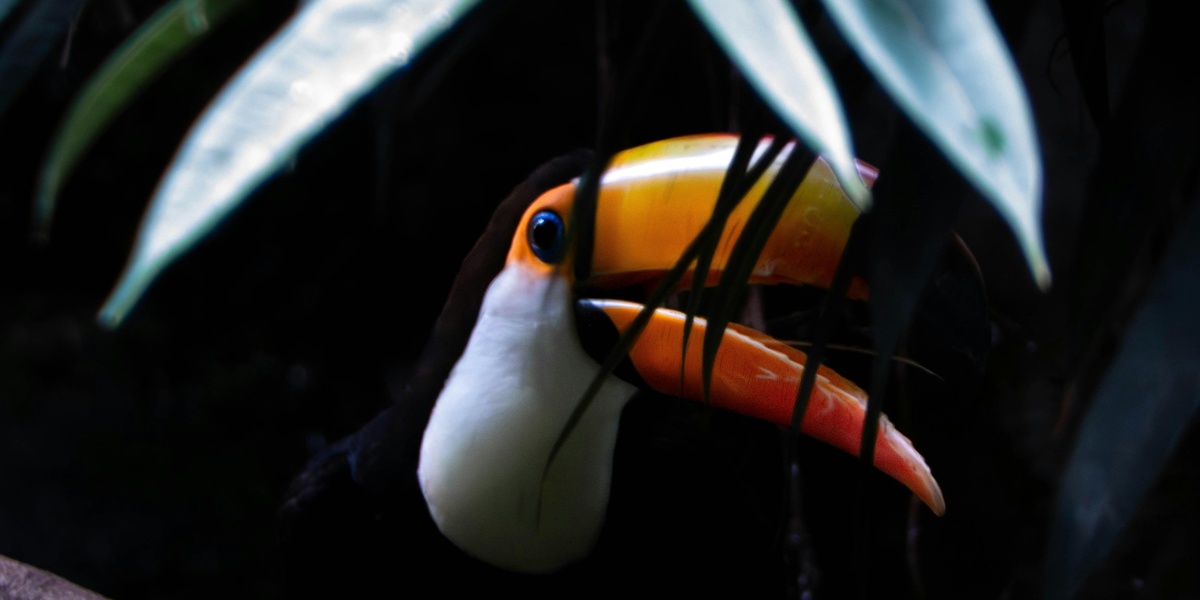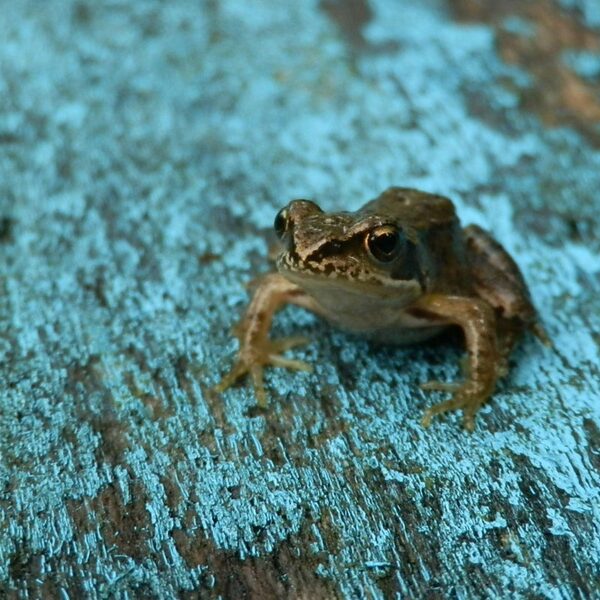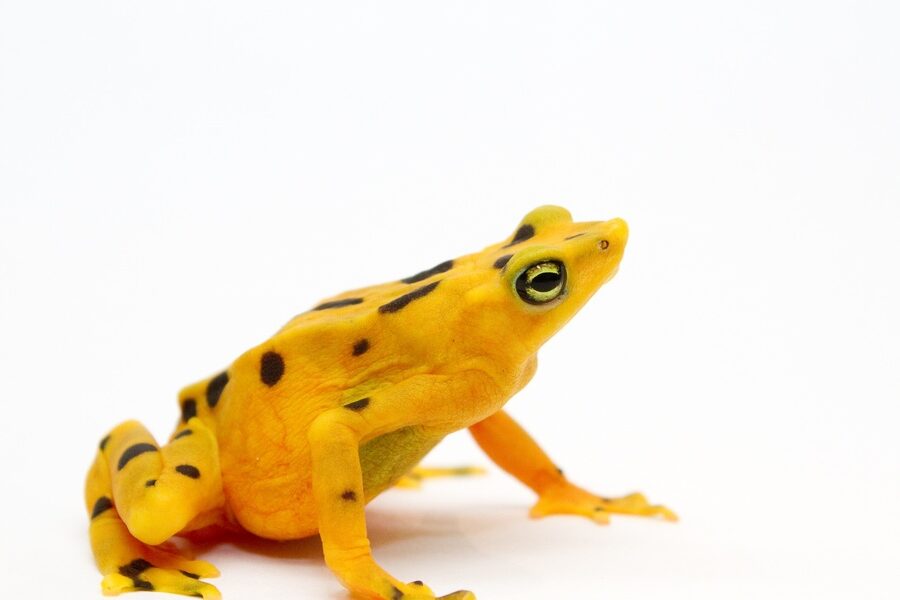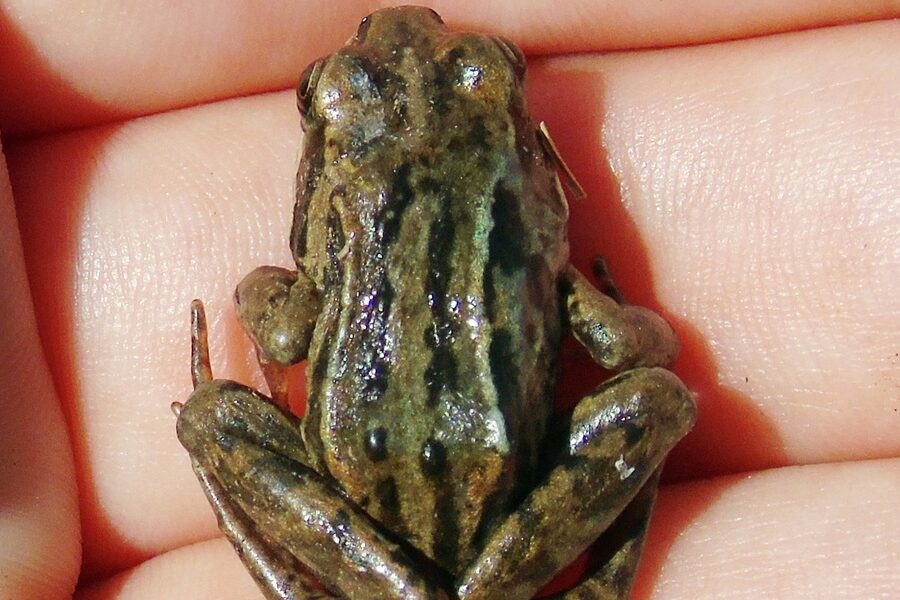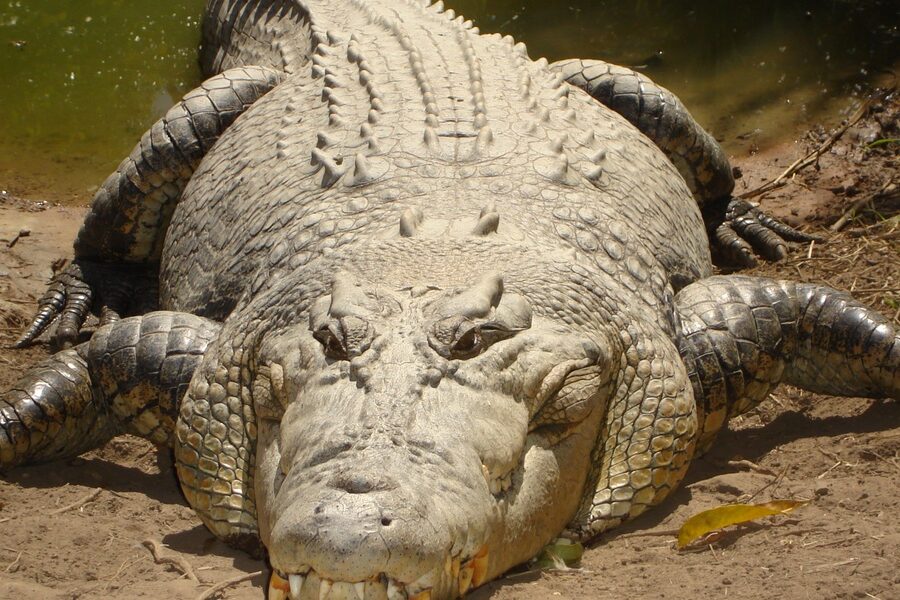The world’s rainforests are vibrant ecosystems, alive with an astonishing array of biodiversity. Among the most visually striking inhabitants are the toucans, instantly recognizable by their vivid plumage and remarkably oversized, colorful bills that stand out against the dense green canopy.
Delving into this fascinating family, you’ll find there are 27 Rainforest Toucans, ranging from the high-altitude Black-billed Mountain Toucan to the more diminutive Yellow-eared Toucanet. In the comprehensive list you’ll find below, each entry is organized to provide essential details, including its Scientific Name, Habitat (Region), and Avg. Length (cm).
What do toucans typically eat?
Toucans are primarily frugivores, meaning their diet largely consists of various fruits found within their rainforest habitats. However, they are also opportunistic omnivores and will supplement their diet with insects, small lizards, eggs, and even the chicks of other birds, especially during breeding season when protein needs are higher.
Why do toucans have such large bills?
While often assumed to be for strength or cracking nuts, the toucan’s large, lightweight bill serves multiple purposes. It’s crucial for thermoregulation, allowing them to regulate body temperature by adjusting blood flow. The bill also helps them reach fruit on branches that cannot support their weight, acts as an intimidation display for predators, and plays a role in mate attraction during courtship rituals.
Rainforest Toucans
| Common Name | Scientific Name | Habitat (Region) | Avg. Length (cm) |
|---|---|---|---|
| Keel-billed Toucan | Ramphastos sulfuratus | Latin America (Southern Mexico to Colombia) | 50 |
| White-throated Toucan | Ramphastos tucanus | Amazon Rainforest (Venezuela, Guianas, Brazil, Colombia, Ecuador, Peru, Bolivia) | 61 |
| Channel-billed Toucan | Ramphastos vitellinus | Tropical South America (East of the Andes) | 48 |
| Choco Toucan | Ramphastos brevis | Chocó Rainforest (Western Colombia and Ecuador) | 47 |
| Red-breasted Toucan | Ramphastos dicolorus | Atlantic Forest (Brazil, Paraguay, Argentina) | 46 |
| Citron-throated Toucan | Ramphastos citreolaemus | Northern Colombia and Northwestern Venezuela | 48 |
| Collared Aracari | Pteroglossus torquatus | Central America to Northern South America (Mexico to Ecuador) | 41 |
| Fiery-billed Aracari | Pteroglossus frantzii | Pacific slopes of Costa Rica and Panama | 43 |
| Curl-crested Aracari | Pteroglossus beauharnaesii | Southwestern Amazon Rainforest | 44 |
| Green Aracari | Pteroglossus viridis | Guiana Shield (Venezuela, Guianas, Northern Brazil) | 33 |
| Lettered Aracari | Pteroglossus inscriptus | Amazon Basin | 33 |
| Ivory-billed Aracari | Pteroglossus azara | Western Amazon Basin | 36 |
| Chestnut-eared Aracari | Pteroglossus castanotis | Amazon and Pantanal regions | 45 |
| Many-banded Aracari | Pteroglossus pluricinctus | Northwestern Amazon Rainforest | 44 |
| Black-necked Aracari | Pteroglossus aracari | Eastern South America (Guianas to Brazil) | 43 |
| Emerald Toucanet | Aulacorhynchus prasinus | Mountainous regions of Central America | 33 |
| Groove-billed Toucanet | Aulacorhynchus sulcatus | Coastal mountains of Colombia and Venezuela | 35 |
| Crimson-rumped Toucanet | Aulacorhynchus haematopygus | Andes of Colombia, Ecuador, and Venezuela | 35 |
| Guianan Toucanet | Selenidera culik | Guiana Shield (Venezuela, Guianas, Northern Brazil) | 33 |
| Golden-collared Toucanet | Selenidera reinwardtii | Upper Amazon Basin | 32 |
| Spot-billed Toucanet | Selenidera maculirostris | Atlantic Forest (Brazil, Paraguay, Argentina) | 33 |
| Yellow-eared Toucanet | Selenidera spectabilis | Humid forests from Honduras to Ecuador | 36 |
| Plate-billed Mountain Toucan | Andigena laminirostris | Andean slopes of Ecuador and Colombia | 48 |
| Black-billed Mountain Toucan | Andigena nigrirostris | Andean montane forests (Colombia to Peru) | 48 |
| Blue-throated Toucanet | Aulacorhynchus caeruleogularis | Montane rainforests of Costa Rica and Panama | 34 |
| White-throated Toucanet | Aulacorhynchus albivitta | Andes of Colombia and Ecuador | 35 |
| Black-throated Toucanet | Aulacorhynchus atrogularis | Eastern Andean slopes (Peru to Bolivia) | 34 |
Images and Descriptions
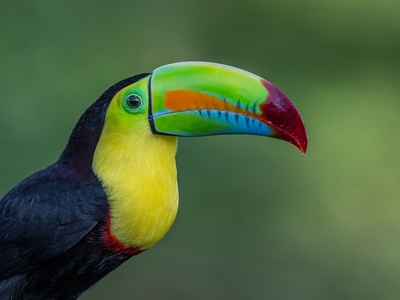
Keel-billed Toucan
Famous for its spectacular, rainbow-colored bill with shades of green, blue, orange, and yellow. This social bird is the national bird of Belize and travels in small flocks through the rainforest canopy, feeding on fruits.
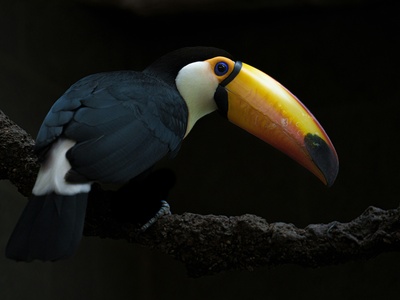
White-throated Toucan
One of the largest toucans, it boasts a massive red-and-yellow or all-black bill depending on the subspecies. Its deep, yelping call is a characteristic sound of the Amazonian dawn and dusk, echoing through the trees.
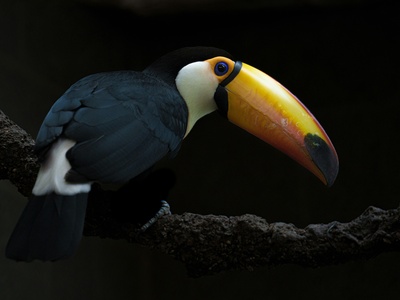
Channel-billed Toucan
This species is known for its black bill with a yellow ridge and blue base. A noisy and social bird, it forages in the rainforest canopy for fruit, insects, and sometimes the eggs of other birds.
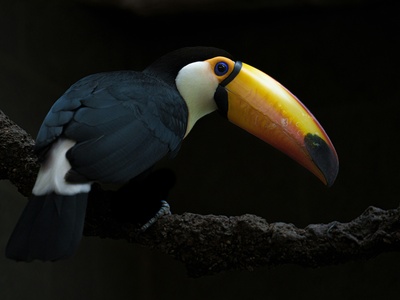
Choco Toucan
Native to one of the world’s wettest rainforests, the Choco Toucan has a striking bill that is yellow on top and black below. It is a key seed disperser, helping to regenerate its lush, humid forest home.
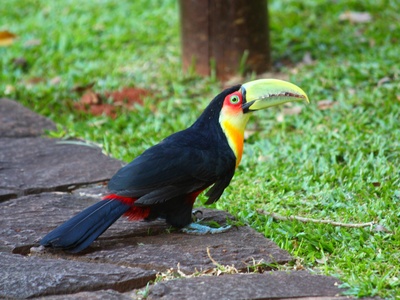
Red-breasted Toucan
Sporting a huge orange-red belly and a pale greenish-yellow bill, this toucan is a vibrant resident of the unique Atlantic Forest. It’s one of the few large toucans found outside the Amazon basin.
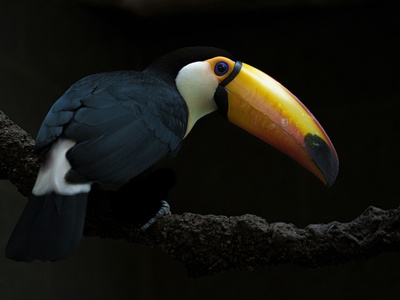
Citron-throated Toucan
Distinguished by its bright yellow throat and a black bill tipped with yellow, this toucan inhabits humid lowland rainforests. It often travels in noisy groups, foraging for fruits and contributing to seed dispersal in its habitat.
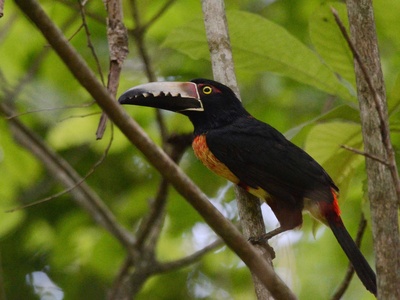
Collared Aracari
A slender, social toucan with a “collar” marking on its neck. It has a patterned, saw-toothed bill and travels in chattering family groups. They often roost together in tree cavities, with tails folded over their backs.
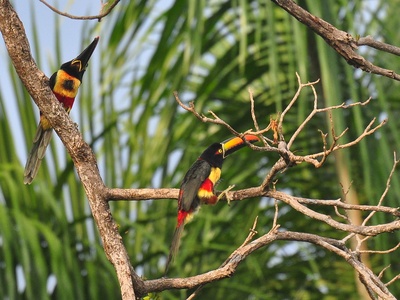
Fiery-billed Aracari
Named for its stunning, flame-colored orange and red bill, this aracari is a jewel of Central American rainforests. It lives in small, active flocks and plays a vital role in dispersing the seeds of forest fruits.
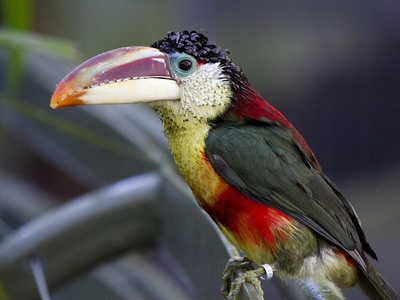
Curl-crested Aracari
Unmistakable due to the unique, glossy black feathers on its head that resemble plastic shavings or curls. This aracari is a highly social and visually stunning bird, often seen foraging in the rainforest mid-story.

Green Aracari
One of the smallest toucans, the Green Aracari male has a striking yellow and maroon bill, while the female’s is darker. They are common in lowland rainforests, where their green plumage provides excellent camouflage.
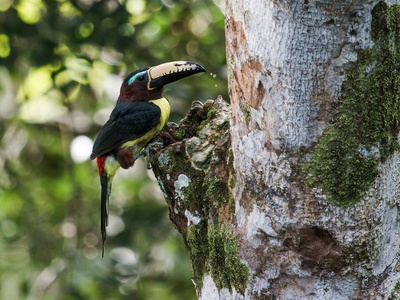
Lettered Aracari
Named for the black, script-like markings on its pale bill, this small toucan is a common sight in the Amazon. It forages for fruit and insects in the canopy and is known for its relatively quiet, croaking calls.
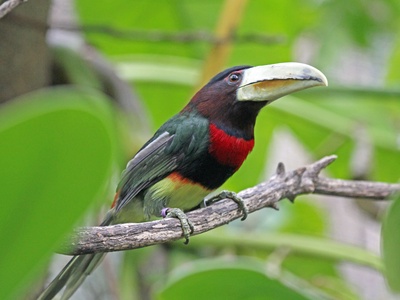
Ivory-billed Aracari
This aracari has a long, clean, ivory-colored bill and a bold red and yellow chest band. It thrives in seasonally flooded rainforests (várzea) and forages in small, active groups for fruits and insects.
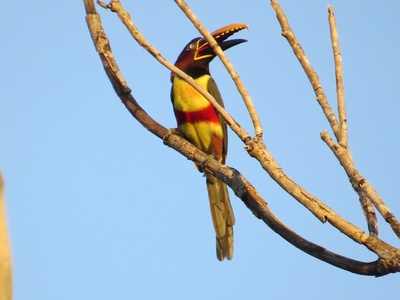
Chestnut-eared Aracari
Identified by a large chestnut-brown patch behind its eye, this is one of the more widespread aracaris. It’s adaptable, found in both dense rainforest and more open woodlands, often following army ant swarms to catch fleeing insects.
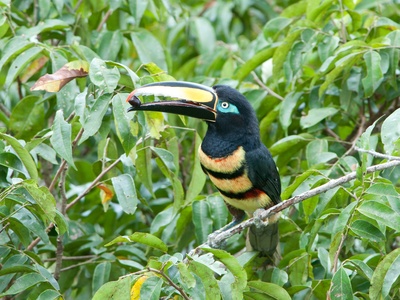
Many-banded Aracari
Aptly named for its two distinct black and red bands across its yellow chest, this is a strikingly patterned bird. It lives in the upper canopy of humid rainforests, often in noisy, fast-moving flocks.
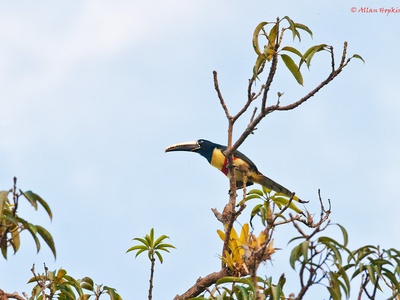
Black-necked Aracari
With a mostly black head and throat and a pale bill, this aracari is a common resident of the Atlantic Forest and nearby regions. It is highly social, often seen flying in single file across forest clearings.
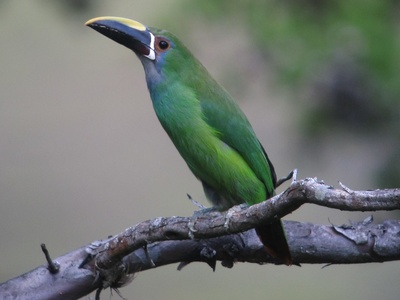
Emerald Toucanet
A vibrant green toucanet with a splash of blue on its throat. This bird lives in humid montane rainforests and cloud forests, where its plumage blends perfectly with the lush foliage as it forages for fruit and insects.
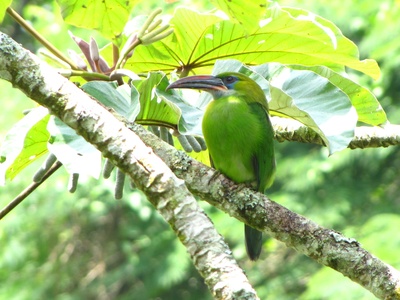
Groove-billed Toucanet
Identified by the distinct grooves on its bill, this toucanet has a blue-gray throat and bright green body. It is a resident of subtropical and tropical moist montane forests, often traveling in small, active groups.
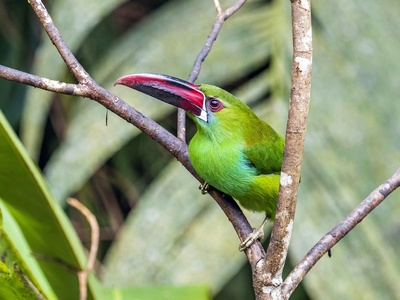
Crimson-rumped Toucanet
This toucanet is easily recognized by its bright crimson patch on its rump, which flashes in flight. It has a dark, maroon-colored bill and lives in the humid montane forests of the Andean slopes.
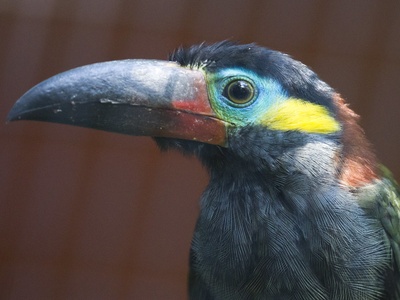
Guianan Toucanet
This species shows strong sexual dimorphism; males are black below with a yellow ear-patch, while females are gray-brown. They inhabit humid lowland forests, where their quiet calls can be heard from the canopy.

Golden-collared Toucanet
Named for the male’s striking yellow collar, this toucanet is a denizen of the western Amazon. Like other Selenidera, the female has a more subdued, brownish coloration. It typically forages quietly in the forest mid-story.
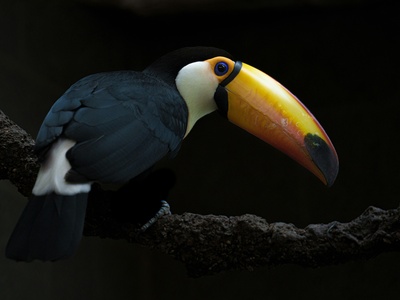
Spot-billed Toucanet
Found only in the Atlantic Forest, the male has a dark bill with several distinct spots or “teeth” marks. The female lacks the male’s black head and chest, showing the typical dichromatism of its genus.
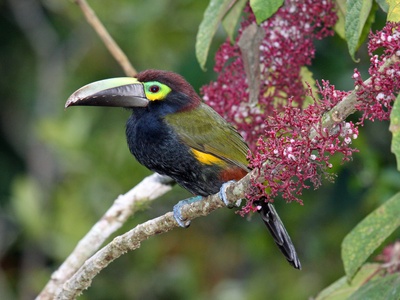
Yellow-eared Toucanet
The largest of its genus, this toucanet is named for the male’s prominent yellow patch of skin around the ear. It is a secretive bird of dense, wet lowland and foothill rainforests, making it difficult to spot.
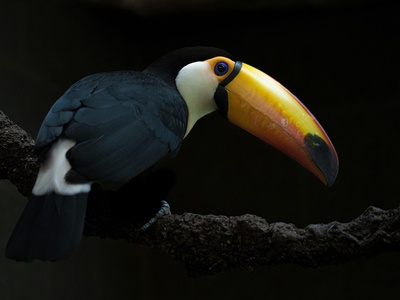
Plate-billed Mountain Toucan
This remarkable toucan has a unique, raised yellow plate on the sides of its large bill. It inhabits the high-altitude montane rainforests of the Andes, where it plays a crucial role as a seed disperser.
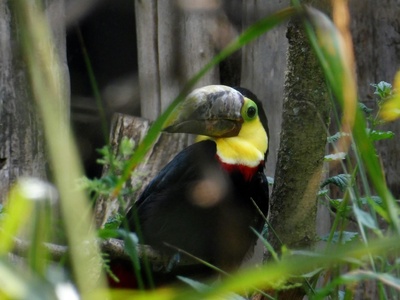
Black-billed Mountain Toucan
Distinguished by its entirely black bill and a striking pale blue patch around the eye, this toucan lives at high elevations. It forages in the canopy of wet, mossy forests, often in pairs or small family groups.
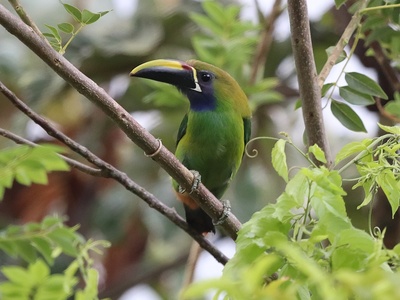
Blue-throated Toucanet
With a brilliant, deep blue throat that contrasts with its emerald green body, this toucanet is a stunning sight. It is an active forager in the canopy of cloud forests and humid montane forests.
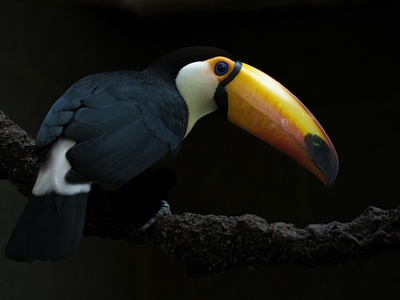
White-throated Toucanet
As its name suggests, this species has a clean white throat that stands out against its green plumage. A common inhabitant of Andean montane rainforests, it often travels in small, noisy flocks through the forest canopy.
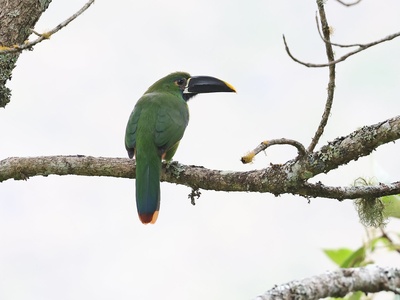
Black-throated Toucanet
Living in the humid montane forests on the eastern side of the Andes, this toucanet has a distinctive black throat. Its green feathers provide excellent camouflage as it forages for fruits and berries among the dense foliage.
